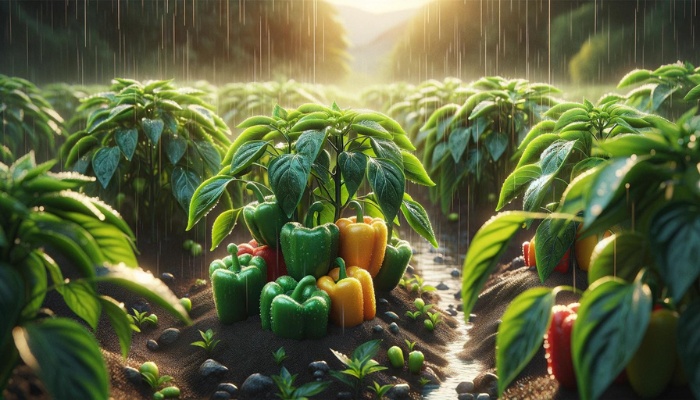While peppers add a burst of flavor and color to any dish, growing them in a square foot garden presents a unique set of challenges and rewards.
You’re tasked with maximizing yield in a minimal space, which means that understanding the essentials of care and growth is imperative.
From selecting the right varieties that thrive in compact areas to mastering the timing for planting and spacing, every step influences your garden’s productivity.
Additionally, knowing when and how to water, feed, and protect your peppers from pests and diseases can make or break your harvest.
Choosing the Right Varieties
Selecting the right pepper varieties is vital for maximizing yield and taste in your square foot garden. You should consider climate adaptation and seed sources to ensure your peppers thrive.
Peppers, being warm-season crops, demand a specific temperature range for optimal growth. Certain varieties are bred to withstand cooler temperatures or to excel in hotter climates.
You’ll want to choose varieties that are well-suited to your local weather patterns to ensure a bountiful harvest.
When it comes to seed sources, it’s not just about picking any packet off the shelf. You need to look for reputable suppliers known for quality and disease-resistant strains.
These seeds have a higher germination rate and offer plants that are more capable of adapting to your garden’s unique conditions.
Selecting seeds from such sources also means you’re starting with a genetically robust foundation, which is essential for healthy growth and yield.
Planting and Spacing Guidelines
Begin by enriching your garden bed with a balanced mix of compost, vermiculite, and peat moss to create a nutrient-rich, well-draining environment.
This foundation supports healthy root development and aids in moisture retention, which is vital for pepper plants.
Germination timing is equally important. Start your seeds indoors about 8-10 weeks before the last expected frost. This head start is essential for peppers because they require a long, warm growing season to flourish.
Once seedlings have emerged and the danger of frost has passed, it’s time to transplant them into your garden.
In a square foot gardening setup, allocate one square foot per pepper plant. This spacing ensures that each plant receives ample sunlight and air circulation, minimizing the risk of disease while maximizing growth.
Carefully transplant seedlings at the same depth they were growing in their containers to avoid stressing the young plants. Adhering to these guidelines will set the stage for a successful and bountiful pepper harvest.
Watering and Feeding Requirements

Ensuring your pepper plants receive the right amount of water and nutrients is vital for their health and productivity. Peppers thrive in well-balanced conditions, and understanding the specifics can make a significant difference.
Here’s a concise guide to keep you on track:
- Maintain Soil pH: Ideal soil pH for peppers is between 6.0 and 6.8. Test your garden’s soil pH regularly, and adjust accordingly using lime to raise the pH or sulfur to lower it. This balance aids in nutrient absorption and enhances growth.
- Consistent Watering: Pepper plants require evenly moist soil. Aim for about 1 to 2 inches of water per week, depending on weather conditions. Overwatering can lead to root rot, but underwatering can stress the plant, affecting pepper production.
- Nutrient Requirements: Apply a balanced, slow-release fertilizer at planting and mid-season. Peppers are particularly responsive to nitrogen early in their growth but require potassium and phosphorus for fruit development.
- Mulching Techniques: Applying a 2 to 3-inch layer of organic mulch helps retain soil moisture, regulates temperature, and reduces weed competition. Mulching also gradually improves soil quality as it decomposes.
Pest and Disease Management
To safeguard your pepper plants from yield-impacting pests and diseases, implement a proactive management strategy. Focusing on soil health is your first line of defense.
A well-balanced soil, rich in organic matter, promotes vigorous plant growth, reducing susceptibility to pest and disease attacks. Regularly amend your soil with compost to enhance its structure and nutrient content.
Companion planting plays a key role in natural pest deterrence. Planting basil or marigolds near your peppers can repel aphids and other pests, due to the natural aromatic compounds these companions release.
This method not only minimizes the need for chemical pesticides but also supports biodiversity in your garden.
Monitor your plants closely for early signs of trouble, such as unusual leaf spots or chewed foliage. Identifying problems early can prevent them from escalating and affecting your yield.
Implementing physical barriers, like insect netting, can effectively keep pests at bay without harming beneficial insects.
Lastly, practice crop rotation annually to disrupt the life cycle of soil-borne pathogens and pests. This simple yet effective strategy keeps your soil healthy and your pepper plants thriving, ensuring a bountiful harvest.
Harvesting and Storage Tips
Using the correct methods for harvesting and storing your peppers will maximize flavor and longevity. Here’s a concise guide to ensure you’re getting the most out of your harvest:
- Harvest Timing: Pick your peppers when they’re fully colored and firm to the touch. This indicates peak flavor and nutrient content. Early morning harvesting can reduce stress on the plants.
- Drying Methods: For long-term storage, consider drying your peppers. Air drying is suitable for thin-walled varieties, while a dehydrator can efficiently process thicker peppers. Drying not only extends shelf life but also concentrates the flavors, enhancing the piquancy and sweetness in your culinary creations.
- Refrigeration Techniques: For short-term storage, place your peppers in the crisper drawer of your refrigerator. This environment maintains humidity and temperature levels optimal for slowing down the ripening process, preserving the crisp texture and vibrant color of your peppers.
- Freezing for Flavor Preservation: Flash freeze whole or sliced peppers on a baking sheet before transferring them to airtight containers. Freezing captures the essence of your peppers, locking in their fresh, garden-grown flavor for future use in cooked dishes.

